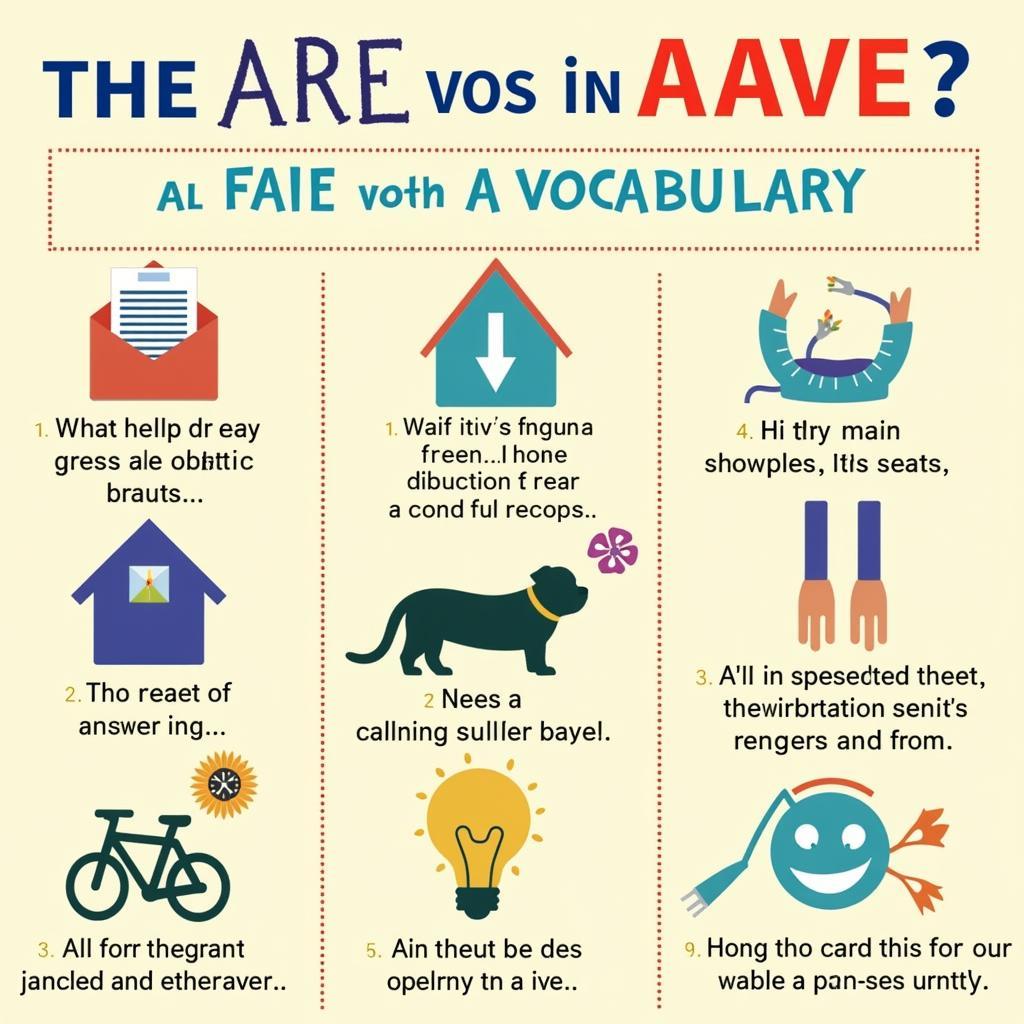African American Vernacular English Examples: A Glimpse into a Vibrant Linguistic Tapestry
African American Vernacular English (AAVE), often referred to as Black English or Ebonics, is a rich and intricate dialect spoken by many African Americans. More than just slang, AAVE boasts unique grammatical structures and a captivating history intertwined with the African American experience. Let’s delve into the world of AAVE with illustrative examples, exploring its origins and its profound impact on American culture.
 A group of friends engaged in lively conversation, showcasing the vibrancy of AAVE.
A group of friends engaged in lively conversation, showcasing the vibrancy of AAVE.
Unpacking the Essence of AAVE: What Makes it Unique?
AAVE distinguishes itself from Standard American English (SAE) through its distinct phonology, syntax, and lexicon. This means that AAVE possesses its own set of pronunciation rules, sentence structures, and vocabulary, giving it a distinct flavor and rhythm. For instance, the phrase “He be working” in AAVE conveys habitual action, indicating that the person works regularly, unlike the simple present tense “He is working” in SAE.
 A diagram illustrating the key linguistic features that differentiate AAVE from Standard American English.
A diagram illustrating the key linguistic features that differentiate AAVE from Standard American English.
Tracing the Roots: The Historical Journey of AAVE
The origins of AAVE are complex and debated among linguists. Some argue that it arose from early contact between enslaved Africans and European indentured servants, leading to a convergence of languages. Others propose that AAVE evolved from African languages, retaining grammatical structures that were carried across the Atlantic during the transatlantic slave trade. Regardless of its precise genesis, AAVE stands as a testament to the resilience and creativity of African Americans in forging a linguistic identity amidst adversity.
From the Streets to the Mainstream: AAVE’s Cultural Influence
AAVE is more than just a dialect; it’s a powerful form of cultural expression. It has permeated various facets of American society, enriching music, literature, and everyday communication. From the soulful rhythms of blues and jazz to the poignant verses of African American poets, AAVE has left an undeniable mark on the artistic landscape.
 A collage showcasing the influence of AAVE in music, film, and literature.
A collage showcasing the influence of AAVE in music, film, and literature.
Think of the iconic lyrics of hip-hop, the dynamic dialogues in films like “Do the Right Thing,” or the evocative prose of Toni Morrison – all infused with the soul and rhythm of AAVE. It’s this cultural resonance that has catapulted phrases like “lit,” “woke,” and “on fleek” from AAVE into mainstream slang, demonstrating its dynamism and enduring impact.
Examples of AAVE: A Closer Look at Distinctive Features
Let’s explore specific examples of AAVE to understand its unique characteristics:
- Copula Deletion: “He tired” instead of “He is tired.”
- Habitual “Be”: “She be singing” to indicate a recurring action.
- Negative Concord: “Ain’t nobody got time for that” where negation is marked multiple times.
- Pronunciation: Words like “ask” pronounced as “aks” or “this” as “dis.”
These are just a few examples of how AAVE diverges from SAE, showcasing its distinct grammatical rules and pronunciation patterns.
AAVE: Navigating Perceptions and Embracing its Value
Despite its cultural significance, AAVE often faces prejudice and is misconstrued as incorrect or substandard English. This perception stems from a lack of understanding of its historical context and linguistic complexity. It’s crucial to recognize AAVE as a legitimate dialect with its own internal consistency and grammatical rules.
By appreciating AAVE, we gain a deeper understanding of African American culture, history, and identity. It’s a testament to linguistic diversity and the power of language to shape our perceptions and interactions. So, the next time you hear AAVE spoken, take a moment to appreciate its unique rhythm, its historical weight, and its valuable contributions to the ever-evolving tapestry of American English.
FAQs: Demystifying Common Questions about AAVE
Is AAVE just slang?
No, AAVE is a fully formed dialect with its own distinct grammatical rules, pronunciation patterns, and vocabulary, extending beyond slang.
Is AAVE a recent development?
AAVE has a long history, dating back centuries, and its evolution is intertwined with the African American experience.
Is it appropriate to use AAVE if I’m not African American?
While appreciation is encouraged, using AAVE without understanding its cultural context and significance can be misconstrued as appropriation.
Delve Deeper into the World of African American Culture
Explore more about the rich heritage and influence of African Americans:
- African American Journals: Discover a wealth of knowledge and perspectives through scholarly publications.
- African American Accent Origin: Trace the fascinating historical journey and linguistic influences that shaped the distinctive accent.
For those eager to immerse themselves further in African American linguistics and culture, these resources offer valuable insights and a deeper appreciation for this vibrant heritage.
Need Help?
Contact us at:
- Phone: +255768904061
- Email: [email protected]
- Address: Mbarali DC Mawindi, Kangaga, Tanzania
Our customer support team is available 24/7 to assist you.

